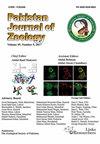巴基斯坦siwalik地区中新世中晚期的有刺猫科动物
IF 0.5
4区 生物学
Q4 ZOOLOGY
引用次数: 1
摘要
Nimravidae家族在Siwalik组中鲜为人知,该组由年龄为18.0-0.6 Ma的淡水矿床组成。在Dhok Ban Ameer Khatoon (Chinji组)和Sethi Nagri (Nagri组的模式地点)中发现的新材料根据犬类的形态归属于Sansanosmilus rhomboidalis。这种回收的材料在巴基斯坦北部的siwalik地区是独一无二的。这也增加了从Chinji组到Nagri组这一有刺猫科动物物种的地层范围。本文章由计算机程序翻译,如有差异,请以英文原文为准。
Barbourofelines from the Middle-Late Miocene of the Siwaliks, Pakistan
The family Nimravidae is poorly known from the Siwalik Group that comprises freshwater deposits having an age that spans 18.0-0.6 Ma. The new material recovered from the Dhok Ban Ameer Khatoon (Chinji Formation) and Sethi Nagri (type locality of the Nagri Formation) is assigned to Sansanosmilus rhomboidalis based on the morphology of canine. The recovered material is unique and rare in the Siwaliks of northern Pakistan. It also increases the stratigraphic range of this barbourofelines species from the Chinji Formation to the Nagri Formation.
求助全文
通过发布文献求助,成功后即可免费获取论文全文。
去求助
来源期刊

Pakistan Journal of Zoology
生物-动物学
CiteScore
1.10
自引率
16.70%
发文量
306
审稿时长
4.5 months
期刊介绍:
Pakistan Journal of Zoology (Pakistan J. Zool.) publishes original articles in English on all aspects of animal life. Generally these articles will be in, or related to one of the following subject areas: Physiology, Cell Biology, Molecular Biology, Genetics, Bioinformatics, Toxicology, Forensic Science, Developmental Biology, Entomology, Parasitology, Microbiology, Biotechnology, Pathology, Palaeontology. Taxonomy, Environmental Biology, Wildlife, Fisheries, Vertebrate and Invertebrate Morphology. Additionally, the journal considers research on health and clinical studies. Short communications are regularly considered, however, uninvited review articles, first records/reports of known species, case reports/studies and survey reports are not published in Pakistan Journal of Zoology.
 求助内容:
求助内容: 应助结果提醒方式:
应助结果提醒方式:


